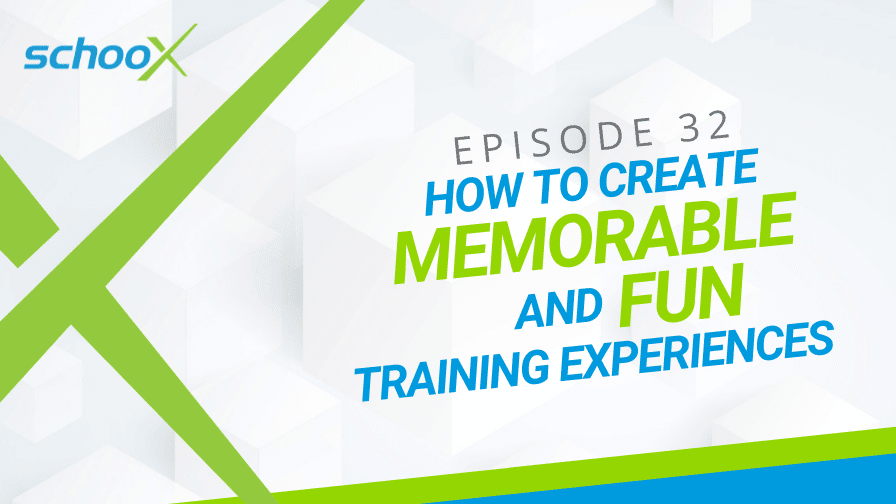June 1, 2021
6 Min. Read

How can you make your learning experiences more memorable and less boring?
Capturing your audience’s attention and holding it can make the transfer of knowledge much more effective.
It’s more important than ever to try and create a memorable connection during the learning process. It’s not enough to simply check the boxes and have all the right content. The content needs to be arranged and presented in a way that sticks in your audience’s minds. You want people to walk away with as much knowledge as possible.
In this episode of The Learning Xchange, Matthew Brown, VP of Learning and Brand Success at Schoox, has some great ideas on making learning more memorable. Listen to the podcast below or keep reading to learn more.
1. Use emotion
The first thing to note is that the best way to connect a learner to training content is to use emotion. This is often done by invoking one or more of the senses at the same time, and there are lots of ways you can do this.
Whether it’s virtual training or in-person sessions, ways to invoke the senses include the clothes you wear, the background you use in virtual learning, and other little Easter eggs that you use throughout your sessions. You could use interactive experiences that get participants to physically do something. This helps to invoke different senses beyond the visual.
When we do this right, it leaves a lasting impression that makes the learner want to come back for more.
Sometimes, this is difficult; for example, it’s hard to make compliance training fun. However, adding something different or unusual into your training can help participants pay attention and remember what you’re saying. When we do this, we increase the likelihood of engagement.
Why is that so important? Increasing engagement and attention in your training sessions means that they’re more likely to learn and remember things.
2. Leverage technology to make learning more memorable
Learning doesn’t have to be dry and boring. You can make it more fun for everyone involved. Of course, fun is going to be relative to the audience and company culture. However, at its core, what we mean is finding ways to bring in interactions, to keep it fresh, and to leverage technology.
You can do this in a variety of ways, for example, quizzes and games, breakout rooms, or collaborative experiences. These are things that can be applied to both in-person and virtual sessions.
If you want to check how well your participants are retaining information, mini-quizzes are a great way to do this. It breaks up any lectures or PowerPoint presentations and keeps the learners thinking and focusing.
3. Include your learners
Another way to freshen things up is to include your learners in your content. Ask them questions that force them to really connect on an emotional level to the content.
Generic questions directed at everyone can be very thought-provoking, but specific questions for individuals can go much further in creating engagement.
4. For memorable learning, do something unexpected
Including something unexpected in your content can also enhance the experience. Even something as simple as wearing a colorful shirt or changing your background can create a fresh experience every time your learners come back.
They may be focused on figuring out what’s different this time, but while they are in that receptive mode, they will listen and hear your content.
5. Make learning part of their day
Another thing to think about is ways to make learning part of their day. A lot of people see workplace training as entirely separate from their job. When it comes time to do a training session, it can feel naturally disruptive and jarring, which isn’t a great experience.
What we should be doing is making the training fit naturally into their day. Make learning more of a regular experience that people become accustomed to on a daily basis – rather than leaving it to once a year.
6. Create a safe space
Another thing that learning professionals and managers can do is to create a safe space for people to take risks and make mistakes. When employees engage with the content, it’s a lot more memorable and fun if they feel comfortable enough to try out new things and ask questions.
This creates a much deeper connection to the learning content at that moment.
7. Involve learners in the content review process
How do you know whether your learning experiences are fun and memorable – unless you ask?
Find a way to include your learners in the content review process to ensure they receive the kind of training they need and want. Hearing their thoughts and feelings about your content makes your learners feel heard. It also helps you tailor the content towards them for the greatest effect.
Honest feedback from your learners is an invaluable part of the content review process. Ask them, does the tone seem right? Does it have the right aesthetic/company culture feel? Are the interactions valuable?
Remember that if you open the doors to this type of feedback, you might hear things you’d rather not. But the most important thing to do is never ignore it.
The worst thing you can do is ask for feedback and then do nothing in response. All that says to the learner is that you don’t value their opinion, which just creates a negative experience for everyone.
While you don’t have to take action on every single piece of feedback, being able to follow up, explore new ways to improve and take feedback on board is crucial. If there’s something you decide not to change and have a good reason why, don’t be afraid to be transparent with your learners and explain why.
Involving your learners and making training a two-way process is such a simple way to make your content more engaging, memorable, and effective.



